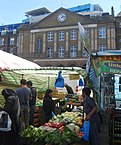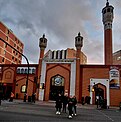
Back وايت تشابل Arabic وايت تشابل ARZ وایتچپل، لندن AZB Уайтчапъл Bulgarian Whitechapel Breton Whitechapel Catalan Whitechapel Czech Whitechapel Danish Whitechapel (London) German Whitechapel Spanish
| Whitechapel | |
|---|---|
Top from left: Royal London Hospital and Whitechapel Market; Aldgate East station, with the Whitechapel Gallery. Middle from left: The East London Mosque; Vallance Gardens. Bottom from left: Altab Ali Park; Whitechapel Bell Foundry; | |
Location within Greater London | |
| Population | 14,862 (Whitechapel ward 2011)[1] |
| OS grid reference | TQ335815 |
| London borough | |
| Ceremonial county | Greater London |
| Region | |
| Country | England |
| Sovereign state | United Kingdom |
| Post town | LONDON |
| Postcode district | E1 |
| Dialling code | 020 |
| Police | Metropolitan |
| Fire | London |
| Ambulance | London |
| UK Parliament | |
| London Assembly | |
Whitechapel is an area in London, England, and is located in the London Borough of Tower Hamlets. It is in East London and part of the East End. It is the location of Tower Hamlets Town Hall and therefore the borough town centre. Whitechapel is located 3.4 miles (5.5 km) east of Charing Cross.
The district is primarily built around Whitechapel High Street and Whitechapel Road, which extend from the City of London boundary to just east of Whitechapel station. These two streets together form a section of the originally Roman Road from the Aldgate to Colchester, a route that later became known as the Great Essex Road. Population growth resulting from ribbon development along this route, led to the creation of the parish of Whitechapel, a daughter parish of Stepney, from which it was separated, in the 14th century.
Whitechapel has a long history of having a high proportion of immigrants within the community. From the late 19th century until the late 20th century the area had a very high Jewish population, and it subsequently became a significant settlement for the British Bangladeshi community. Whitechapel and neighbouring Spitalfields were the locations of the infamous 11 Whitechapel murders (1888–91), some of which were attributed to the unidentified serial killer known as Jack the Ripper. These factors and others have led to Whitechapel being seen by many as the embodiment of London's East End, and for that reason it is often used to represent the East End in art and literature.[2]
Landmarks include Tower Hamlets Town Hall, the Royal London Hospital and the East London Mosque.
- ^ Census Information Scheme (2012). "2011 Census Ward Population figures for London". Greater London Authority. Retrieved 17 October 2023.
- ^ Brewers Dictionary of London Phrase and Fable, Russ Willey, Chambers, 2009
© MMXXIII Rich X Search. We shall prevail. All rights reserved. Rich X Search






